P3050
Natural Resource Conservation in Agriculture
A Landowner’s Guide for Environmental Stewardship in the Mississippi Alluvial Valley
Acknowledgements
The authors extend thanks to all of those who contributed to the development of this landowner guide in the past or present. This includes all REACH collaborative producers and landowners and the following individuals: Dan Prevost, Dr. Robbie Kröger, Dr. Billy Kingery, and Dr. Wes Burger.
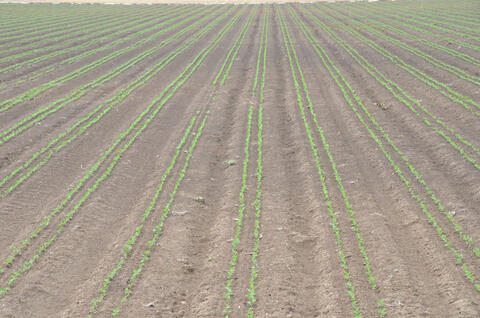
Contents
I. Introduction: REACH
II. Mississippi Water Resources
History of the Mississippi Alluvial Valley
III. Moving Soil Management from Extractive to Renewable
IV. Agriculture Conservation for Wildlife Habitat & Biodiversity
Wildlife in Agricultural Landscapes
V. Conservation and Best Management Practices
Residue and Tillage Management
VI. Role of NRCS & Resource Conservation Planning
Who Can Help Me with the Plan?
VII. Farm Bill & Financial Assistance
Conservation Reserve Program (CRP)
Conservation Stewardship Program (CSP)
Environmental Quality Incentives Program (EQIP)
Agricultural Conservation Easement Program (ACEP)
Regional Conservation Partnership Program (RCPP)
VIII. Bibliography
Introduction: REACH
Global concern for water security continues to grow alongside expanding water resource regulation in many regions of the world. Efforts to avoid regulation require local governments and stakeholders to take a proactive approach to conserving local water resources. Throughout many regions of the U.S., including Mississippi, there is an urgent need for 1) accountability with regard to agriculture’s impact on the environment and 2) documentation of how on-the-ground programs and conservation practices impact natural resources. The Mississippi State University REACH (Research and Education to Advance Conservation and Habitat) program was developed as a producer-driven program to address those needs and provide support to Mississippi producers.
REACH provides landowners with coordination and support for documenting the benefits of conservation efforts to natural resources and agriculture. This is done using research with conventional science followed by outreach through a dynamic network of collaborators, thereby expanding the impacts of findings. The goal is to demonstrate how conservation and agriculture have mutual benefits and to provide technology and information transfer to producers. This approach combines research with innovative outreach and helps landowners discover the agricultural and natural resource benefits of integrating conservation practices with traditional production methods.
Mississippi Water Resources
History of the Mississippi Alluvial Valley
The millions of acres of agricultural land that span the Mississippi Alluvial Valley capitalize on the rich soils of the alluvial floodplain. This region, south of the Mississippi River’s confluence with the Ohio River, was once the greatest bottomland hardwood forest on Earth, spanning 24.7 million acres, according to the U.S. Forest Service. Because this area experienced significant annual flooding, levees were constructed, allowing for drainage and cultivation of the land. This also served to increase deforestation of Mississippi’s bottomland hardwood forests. Now one of the most prominent agricultural regions in the world, the Mississippi Alluvial Valley is key to producing food and fiber to meet the demands of a growing global population. However, increasing natural resource concerns in both agriculture and downstream waterbodies have led to policy discussions at federal and state levels throughout the Mississippi Alluvial Valley and the greater Mississippi River Basin.
Water Quantity & Quality
With the global population projected to grow by 2–3 billion people over the next 40 years, the demand for water for domestic use and to produce food and fiber is only going to increase. To meet production demands, it has become necessary to apply fertilizers at increasing rates over the last 50 years. When storm events occur, sediment and nutrients are washed from production fields to downstream water bodies. Runoff from agricultural fields has been identified as the primary source of nutrient loading to riverine systems and the Gulf of Mexico. As such, there is an urgent need to better protect water resource quality.
Areas of intense agricultural production consume vast freshwater resources across the globe. Irrigation for agriculture consumes the greatest amount of water (70 percent), while, in the U.S., irrigation accounted for 38 percent of freshwater withdrawals in 2010.1 In the Mississippi Delta, irrigation accounts for 98 percent of water use from the Mississippi Alluvial aquifer. While the Mississippi Alluvial Valley receives far more rainfall than many regions of the U.S. (averaging 59 inches in the south and 45 inches in the north annually),2 much of that rainfall does not recharge groundwater supplies and does not exceed some regional annual water withdrawals. Consequently, there is an opportunity (and a need) to ensure the longevity of Mississippi’s water resources to support the state’s citizens and agricultural commerce.
In addition to impacting water availability, agricultural production practices impact water quality as a major source of surface and groundwater pollution. Throughout the Mississippi River Basin, sediments and nutrients ultimately flow to the Gulf of Mexico. These nutrients, sediments, and pesticides from agricultural practices accumulate throughout the Mississippi River Basin from Minnesota to Louisiana and are released into the Gulf of Mexico. The Delta region supports a $7.51 billion agricultural industry. Finding a way to secure a sustainable future for agriculture is critical to the livelihood of Mississippians and crucial for global food and water resources. Industries must work together and foster a community of environmental stewardship toward our freshwater and marine resources to secure future growth.
Downstream of the Mississippi Alluvial Valley, Mississippi’s fisheries industry requires high-quality water resources to thrive. The Gulf of Mexico ecosystem is of great environmental and economic importance to the livelihood of Mississippians. Sales impacts of the Gulf of Mexico region’s seafood industry reached $247 million in Mississippi in 2011, according to a report from the National Oceanic and Atmospheric Administration, but the fisheries industry is at the mercy of other industries that threaten water quality. These threats include off-shore oil recovery, maritime activities in Mississippi’s three coastal ports, and agricultural production in upland and Delta regions.
Moving Soil Management from Extractive to Renewable
History
After a century of intense cultivation in the Mississippi Delta, once-rich alluvial soils are showing signs of degradation, and, like many regions globally, producers depend upon inorganic nutrients to maintain crop yields. Fertilizer application is necessary when soil nutrient removal by crops exceeds nutrient inputs (fertilizers), a condition that is not sustainable. Cropping sustainability translates into consistently achieving high crop yields without damaging the soil’s capacity to produce such yields.
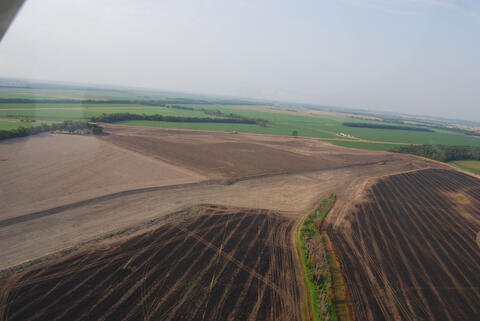
Healthy Soil Initiatives
Soil health or soil quality is defined as the continued capacity of soil to function as a vital living ecosystem that sustains plants, animals, and humans.3 Maintaining and building healthy soils is the foundation for developing sustainable farming systems to supply food and fiber to the world.
Healthy soils provide a multitude of services that simultaneously benefit agriculture and the environment. Moreover, healthy soils benefit all farmers, from small vegetable gardeners to large row-crop producers. Benefits of healthy soils include the three Ps:
- Production increases: Healthy soils are typically more productive because they have more organic matter and soil microorganisms. These increased organic components improve soil structure, aeration, water retention, drainage, and nutrient availability for plant growth.
- Profit increases: Soils are healthier when tillage is reduced and fertilizer is used efficiently, meaning fewer passes over fields and no excess fertilizer inputs. Profit margins can increase when labor, fuel, and crop inputs are optimized.
- Protection of natural resources: Maintaining soil cover year-round can sequester carbon from the air and store it in the soil, benefiting air quality, soil health, and wildlife and plant diversity. Increased organic matter enables soil to hold more water and reduces runoff. Favorable soil water retention combined with nutrient management practices prevents nutrients from leaving fields and contaminating water bodies, protecting water resources and aquatic habitats. Additionally, reducing trips across fields reduces emissions and improves air quality.
Recognition of soil as the fundamental component for food security represents a significant shift in the way we view and manage agricultural production. It’s important to understand that maintaining and rebuilding soil health, particularly organic matter, takes time. Inorganic nutrients are often required for ensuring sufficient crop yields and food security. However, when inorganic and organic nutrient sources are used together, their benefits can be complementary for soil health and the environment. Various stakeholder groups and government agencies have developed soil-health initiatives to develop a better understanding of how management practices can positively alter the soil ecosystem. One prominent agency in soil conservation is the USDA Natural Resources Conservation Service (NRCS). NRCS provides a few basic steps to begin moving along this path: 1) keep soil covered as much as possible, 2) disturb soils as little as possible, 3) use cover crops and crop rotation to feed soil, and 4) develop a soil-health management plan.
Agricultural Conservation for Wildlife Habitat & Biodiversity
In 1912, Theodore Roosevelt said, “There can be no greater issue than that of conservation in this county.” More than a century later, that statement still rings true. Despite Roosevelt’s caution, natural habitats continue to be converted to human purposes of food and fiber production, energy and commerce, and urban development. Although pressure to address food security demands will continue to rise with increasing human populations, conservation of natural resources does not, by default, have to take a back seat. Recent global events such as massive mudslides, coastal flooding, impaired water supplies, and burgeoning pest populations are examples of the consequences of failing to acknowledge the connections between human well-being and conservation-oriented farming practices.
Fortunately, federal, state, and private programs provide producers with conservation options. Landowners no longer have to choose between the personal costs of lost crops or habitat restoration and the societal benefits of environmental conservation. Many producers are now adopting a more diversified business model that includes conservation as a part of their portfolios, recognizing that conserving wildlife habitat and other natural resources translates into a more sustainable operation.
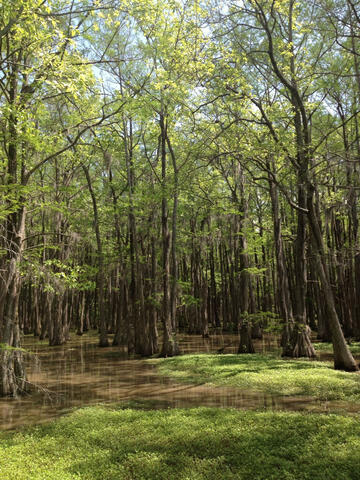
Wildlife in Agricultural Landscapes
The diversity of wildlife species in an area is dependent upon the habitat present in the landscape. Mississippi was historically covered by a diverse array of natural habitats, including bottomland and upland hardwood forests, wetlands and swamps, longleaf pine forests, prairies, meandering rivers, briny estuaries, and sandy coastlines. Because of this diversity, wildlife was plentiful and varied.
Today, these habitats have been largely lost, their remnants intertwined with human-dominated landscapes. Consequently, benefits associated with these native ecosystems and their wildlife inhabitants—services such as flood control, pollination, pest control, and nutrient cycling—have also been compromised.
In the Mississippi Alluvial Valley, available wildlife habitat is largely restricted to ditches, field edges, levees, remnant forest tracts, altered waterbodies, and agricultural fields. Elsewhere in the state, pastures, hay fields, and timberlands provide limited opportunities for wildlife. Under today’s environmental conditions, wildlife is no longer an accidental byproduct of agricultural production. Forethought and planning will be needed to intentionally create wildlife habitat and the benefits it provides.
Waterfowl
The Mississippi Flyway functions like a highway in the sky for migrating waterfowl, funneling birds from the breeding grounds in the upper Midwest and Canada to the wintering grounds in the southern U.S. and northern Mexico. Historically, the Mississippi Alluvial Valley has been vital to sustaining waterfowl populations during this annual journey. Even in its current altered state, this region still continues to provide critical support to migrating birds.
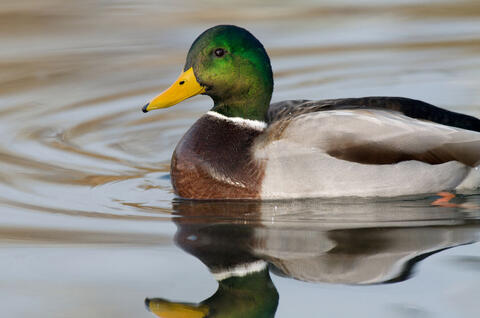
Snow geese, white-fronted geese, and sandhill cranes take advantage of the waste grain available in large production fields, whereas dabbling ducks such as mallards and northern shovelers use oxbow lakes and flooded bottomland timber. Deeper water in lakes, rivers, and reservoirs provides feeding and resting habitat for diving ducks. Research has shown flooded rice fields can serve as important winter waterfowl habitat in the absence of natural wetlands.4 With careful, intentional management, this region can continue to contribute to conservation of the nation’s waterfowl populations while allowing for economic and recreational opportunities.
Game Species
The Mississippi Alluvial Valley was once home to a wide variety of game species. Fur-bearing mammals such as otters, mink, raccoons, bobcats, and black bears were plentiful and viewed as a valuable resource by early European settlers. Deer, turkey, and rabbits abounded on higher ground and along forest edges. The land provided bountiful resources for human inhabitants.
The 1800s and early 1900s were marked by a period of excessive overharvest and habitat destruction, leading to dramatic declines in wildlife abundance. Today, populations of many of these species have recovered thanks to habitat restoration, species reintroduction, and regulated harvest. Populations of deer, turkeys, raccoons, and other game species are supported by habitat made available through collaboration with private, state, and federal landowners.
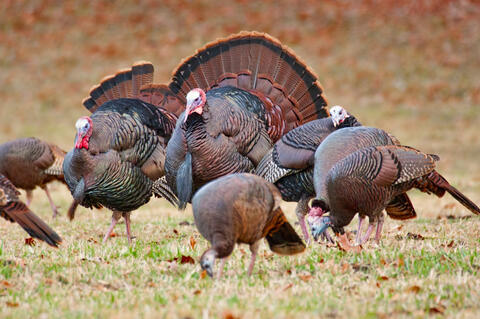
Songbirds and Others
Waterfowl are not the only birds that use the Mississippi Flyway. Songbirds, shorebirds, and hawks rely on the Mississippi River and its associated Delta habitats for survival during migration. Other species live in the Mississippi Alluvial Valley, taking advantage of the relatively temperate climate. In recent decades, simplification of the landscape as a result of large-scale farming has pushed some bird species to the edge of survival, as the habitats they require have been marginalized or lost. River channelization and drainage canals have severely limited sandy beaches for nesting and mudflats for foraging by shorebirds. Grassland species, valuable for their natural ability to control insect pests, have few remaining places to nest or overwinter.
However, recent research has indicated conservation practices implemented in agricultural systems have a positive impact on birds.4 For example, reduced-till or no-till practices provide foraging opportunities for overwintering birds. Field buffers take marginal land out of production and provide nesting and brood-rearing habitat, supporting insect-eating birds. Wading birds feed and rest in flooded rice fields, aiding nutrient cycling through soil disturbance and waste deposition.
Invertebrates
Invertebrates are animals without backbones. This is a huge group of wildlife that can be found in almost every conceivable habitat—soil, water, forests, wetlands, grasslands, and crop fields. Invertebrates include creatures like snails, worms, spiders, and crayfish.

Insects are the most recognizable kind of invertebrate because of their visibility and reputation as agricultural pests. Although many insect species deserve their bad reputations, the majority of insects and other invertebrates are either benign or important members of successful agricultural production systems. Plant decomposition, nutrient cycling, pest population control, and pollination are just a few of the ecosystem services provided by invertebrates.
Pollinators, which include birds, bees, butterflies, moths, flies, beetles, bats, and some other mammals, are critical to healthy agricultural landscapes. For example, native bees are valuable crop pollinators. The 2008 Farm Bill made pollinators and their habitats a priority, while the more recent 2014 Farm Bill added targeted support for the creation of honey bee habitat.
A Growing Need
for Wildlife Conservation
Roughly 70 percent of land in the lower 48 states is in private ownership. There simply is not enough public land—especially in the southeast U.S.—to provide sufficient wildlife habitat for long-term sustainability.
There are a number of management practices that landowners can use to improve wildlife habitat on their property. Wildlife response to these practices will depend on how much and what kind of habitat is available and its quality and distribution around the farm. Also, the types of practices implemented will influence the kinds of wildlife that will be attracted. If habitat is created in a landscape that contains other existing, suitable habitat, landowners may see great improvements in farmland wildlife populations while sacrificing only minimal production acreage. In contrast, farms surrounded by large tracts of unsuitable wildlife habitat will be less responsive to minor habitat improvements.
Conservation and Best Management Practices
To address looming environmental issues and move agricultural production in the U.S. toward sustainability while also increasing productivity, conservation practices will need to be effective and properly implemented. Moreover, greater adoption at larger scales will be necessary, especially throughout intensely farmed agricultural areas, to conserve soil, water, and habitat resources. The following sections offer information regarding some of the more effective and readily adopted conservation practices throughout the Mississippi Alluvial Valley.
Nutrient Management
Nutrient management (NRCS conservation practice standard 590) is an approach that aims to maximize plant productivity while minimizing environmental consequences. With this practice, producers manage the amount, source, placement, and timing of plant fertilizer amendments, typically as prescribed in a plan that accounts for available nutrient sources and production practices. Together, these variables influence available nutrients, crop yields, and environmental stewardship.
Nutrient management planning is a best management practice that is applied to all forms of fertilizer applications, from inorganic to manure. Nutrient management plans are farm-specific, tailored to available inputs, soils, natural ecosystem features, and management objectives. Nutrient management planning follows a few basic principles: 1) know what you have, 2) know what you need, 3) manage wisely, and 4) document the management. Managing fertilizer inputs may save money because you apply only what is necessary and you target amendments where they are most needed to meet crop yields. Nutrient management also has substantial benefits for the environment, as strategic fertilizer applications reduce nutrient loss from fields to downstream waters and protect surface and groundwater resources. Additional benefits include protecting air quality by reducing nitrogen emissions and maintaining or improving soil conditions.
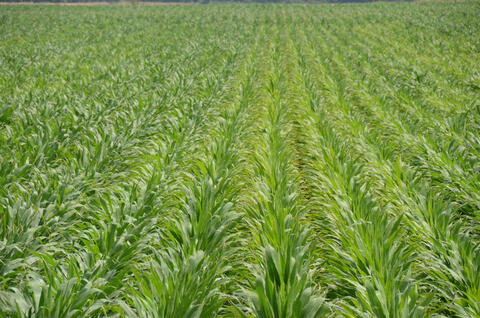
Practicing the 4Rs
The most basic approach to nutrient management is to adopt the 4R nutrient stewardship concept: right source, right rate, right time, and right place for nutrient application. This concept helps producers optimize nutrient management, increase crop yields, improve fertilizer efficiency, and minimize impacts to the environment. Nutrient management is a logical first step to providing economically, environmentally, and socially sustainable crop nutrition.
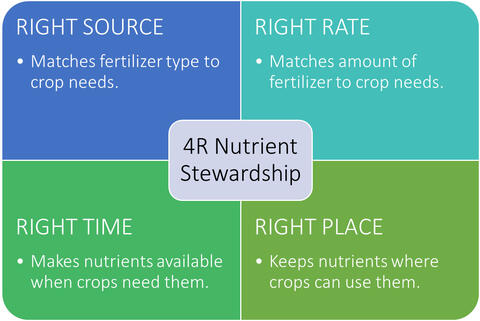
Residue and Tillage Management
Residue and tillage management (NRCS conservation practice 329) also includes no-till, strip-till, and direct seeding. These practices address the amount, orientation, and distribution of crop and other plant residue covering soil year-round. The common characteristic is that the only tillage performed is a narrow strip prepared by coulters, sweeps, or similar devices.
Residue and tillage management benefits soil organic matter, moisture, aeration, aggregation, and productivity. Decomposition of residue on the soil surface supports a healthy population of earthworms and other organisms. Increased water infiltration helps to reduce sheet erosion and chemical runoff, improving water quality for humans and wildlife. Crop residues also provide food and shelter for wildlife such as waterfowl. This practice can also be paired with a conservation cover crop (below) to remedy soil compaction.
Cover Crops
Cover crops (NRCS conservation practice 340) are planted as a soil management tool that can provide multiple benefits to a cropping system. Cover crops include grasses, legumes, or small grains planted in fall and terminated before planting. Benefits of cover crops to cropping systems include reducing erosion, maintaining and increasing soil health, reducing water quality degradation, suppressing weeds, improving soil moisture efficiency, and minimizing soil compaction. Cover crops offer versatility in that they can be used in any cropping system.
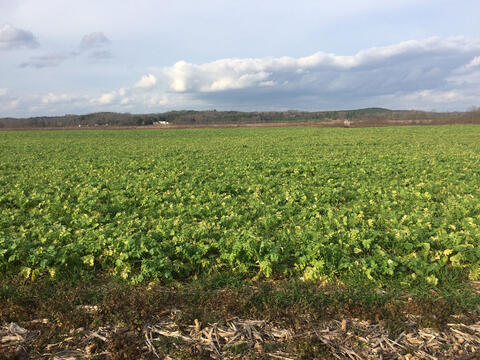
Buffers
Buffers offer many benefits, including 1) improving and providing habitat for aquatic, semiaquatic, and terrestrial organisms, 2) providing a source of debris habitat for aquatic organisms, and 3) improving and protecting water quality, stream bank stabilization, and carbon storage in the biomass and soil.
Riparian forest buffers (NRCS conservation practice 391) are areas of trees and/or shrubs that are adjacent to flowing or standing bodies of water. The vegetation extends a specified distance from the body of water to provide sufficient protection from nonpoint source runoff. This practice is designed to serve as a buffer between agricultural fields and environmentally sensitive areas such as streams, lakes, wetlands, oxbows, or other downstream waters. Riparian buffers serve as protection for waterways from erosion and degradation, and they enhance wildlife habitat. Tree roots stabilize stream banks and slow water flow, thus reducing soil loss to erosion. Tree canopies provide shade, keeping water temperatures cool for aquatic life. Bats forage along riparian zones, feeding on flying insects and reducing agricultural pests.
Alternatively, if a forest buffer isn’t feasible or desired, establishing a riparian herbaceous cover (NRCS conservation practice 390) is an option. This practice refers to a buffer of grasses, grass-like plants, and/or forbs that are tolerant of intermittent flooding or saturated soils. These are established between agricultural areas and aquatic habitats to slow runoff and interrupt sediment transport.
Field borders are cost-effective ways to create wildlife habitat while protecting adjacent waterways. This can be accomplished by removing low crop-yield areas like field corners or woodland edges from production. Research shows 30-foot buffers of native herbaceous vegetation can provide important habitat for pollinator insects and insect-eating birds. Periodic disturbance with light disking or prescribed fire will maintain good grassland structure and composition and prevent woody invasion.
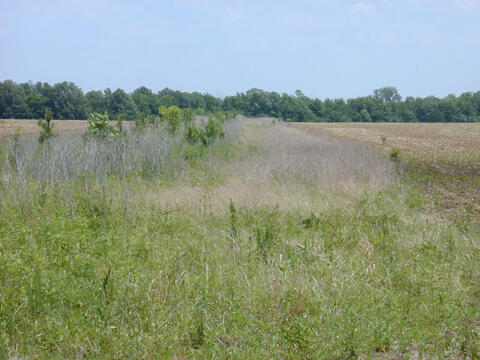
Similarly, filter strips planted along contour lines, ditches, streams, and other water bodies can prevent soil and agricultural chemicals from leaving crop fields while providing habitat for grassland species of birds and beneficial invertebrates.
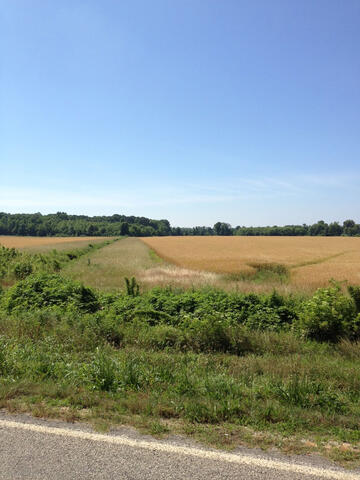
Slotted Pipes
Slotted inlet pipes (NRCS conservation practice 410) or slotted board riser pipes (NRCS conservation practice 587) are used in surface-drained fields. Water leaving the field is directed through a fixed-elevation pipe into a drainage outlet. The pipe is typically set beneath a perimeter pad (earthen dike; NRCS conservation practice 536). The slot on the field-end of the pipe slows water flow and encourages sediment accumulation and retention.5
Slotted inlet pipes minimize soil loss and decrease sediment in runoff by preventing head-cutting within the downstream drainage ditch. Preliminary research shows that between 7.3 and 41.6 pounds of phosphorus are retained per pipe. Maintenance of pipes is required to ensure their effectiveness.5 Preliminary data suggest cleaning sediment from behind pipes every 396 days or about once a year.5
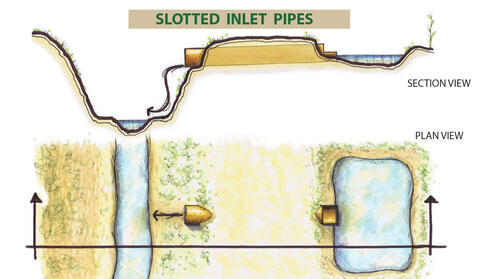
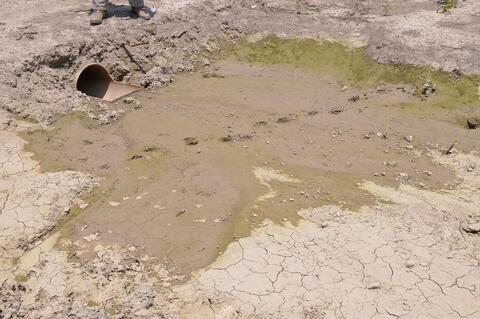
Drainage Water Management
Drainage water management (NRCS conservation practice 554) includes the winter flooding of agricultural fields. This is often achieved by using boards within slotted board risers to capture and hold surface water in agricultural fields. Field flooding provides important food resources for wintering waterfowl and water birds. Waste grain such as rice has been shown to be valuable and desirable for migrating birds. Short-term flooding can improve soil condition and reduce early weed competition. Foraging waterfowl add nutrients and help break down organic matter, improving soil nutrient loads. Visiting waterfowl also provide recreational value that can be both aesthetically pleasing and economical.
Wetland and bottomland hardwood restoration is also possible in many places in the state. Incentive programs are available to landowners to offset the associated costs of implementation and management. Pursuit of these options can remove marginal land from production, reduce crop loss to flooding events, benefit water and soil conservation, diversify economic enterprises via hunting leases, and restore native habitats for wildlife.
Two-Stage Ditches
Two-stage ditches (NRCS conservation practice 582, open channel) are designed to incorporate floodplain benches into a typical drainage channel. This practice can be used in both tile-drained and surface-drained acreage. Creating a two-stage ditch requires widening a channel to increase the amount of water the ditch can capture. The design mimics natural floodplains, allowing water to spread out and slow down, improving channel stability and sustainability. It was developed by observing stable streams and rivers and the associated natural processes that reduce erosion, allow more time for sediment and nutrient removal, and prevent flooding.6 Widening the channel and capturing more water also maintains conditions more suitable for vegetation, insects, and wildlife.
Two-stage ditches improve typical drainage functions while also improving ecological function. Two-stage ditches also reduce the need for maintenance, saving producers labor and money. In some cases, economic benefits were found to offset the (minimal) loss of productive land due to widening the channel.3
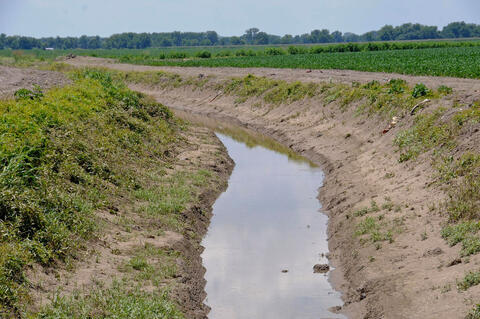
Low-Grade Weirs
Low-grade weirs (NRCS conservation practices 410 and 587) are small check dams or impoundments placed at intervals within a channel (dependent on the channel slope and length to hold a certain volume).5 These structures are constructed by creating an earthen berm, which is overlaid with a fabric mesh for stability and then reinforced with an interlocking, prefabricated concrete structure or riprap (or both, depending on the size of the channel).
Functionally, low-grade weirs increase the water-holding ability of a drainage ditch and retain that water longer to enhance processes that remove sediment and nutrients.5 Research has shown that weirs can alter flow velocities and nutrient runoff.5 Weirs have also been shown to reduce accumulated sediment7 and nutrient runoff.8
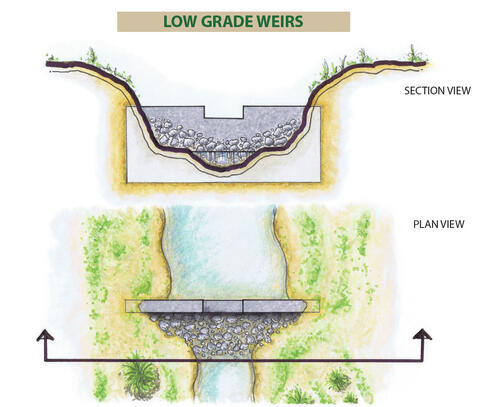
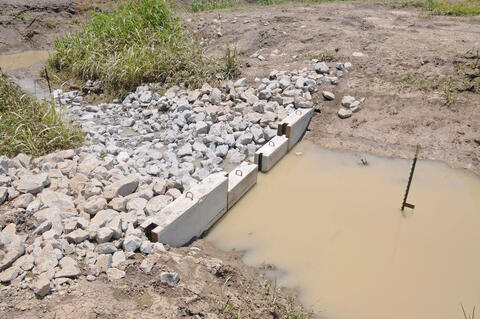
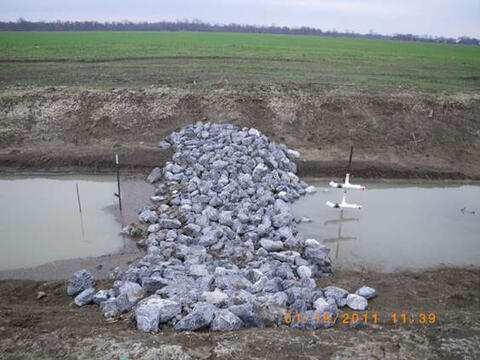
Tailwater Recovery Systems
A tailwater recovery system (NRCS conservation practice 436, irrigation regulating reservoir, or 447, irrigation system, tailwater recovery) is a water-storage structure, often a widened ditch, used for catching irrigation water or rainfall that runs off the landscape for later reuse. The system increases water use efficiency, increases retention time, and reduces energy consumption.
Economic benefits can be experienced, as pumping surface water is often less costly than pumping groundwater. Capturing and retaining runoff water also has benefits for water quality. Research has documented that tailwater recovery systems reduced suspended sediment, phosphorus, and nitrogen loading to downstream waterbodies by 43, 32, and 44 percent, respectively.
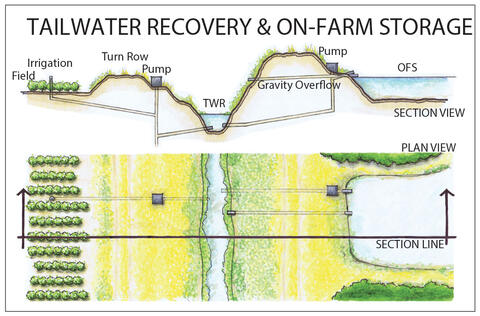
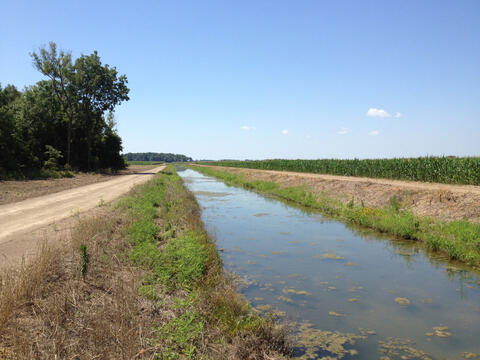
Irrigation Water Management
Irrigation water management (NRCS conservation practice 449) increases irrigation efficiency by determining and controlling the volume, frequency, and application rate of irrigation water. This approach is primarily used to manage soil moisture to promote plant growth, but it also optimizes water use and minimizes irrigation-induced erosion. It can be implemented on all irrigated lands and adapted for site conditions (e.g., slope, crop, soil, water quantity, water quality).
This practice requires an irrigation water management plan, developed in collaboration with an NRCS technical service provider, which will guide proper management of irrigation water. Programs available through the Mississippi State University Extension Service, such as PHAUCET (Pipe Hole and Universal Crown Evaluation Tool) and RISER (Row-crop Irrigation Science and Extension Research), have been developed to further assist producers in increasing their irrigation efficiency.
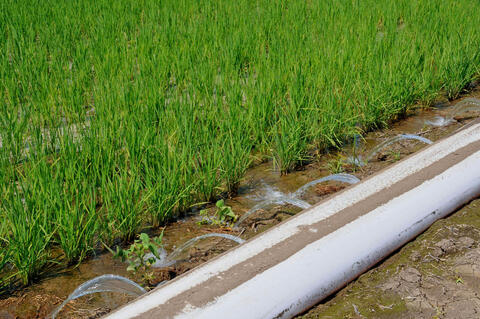
Role of NRCS & Resource Conservation Planning
Why Do I Need a Plan?
In the same fashion any business would lay out a 5- or 10-year plan, it is important for producers to have a business plan that includes reinvestment in the most critical resource they have—their land. Ensuring the operation can persist for generations will require a view toward conservation of the resources necessary for sustainability. This planning process bridges producers’ economic needs and societal demands with the natural ecosystem to sustain resources for the long term.
What Does the Plan Look Like?
Conservation planning involves nine steps.
- Step 1: Identify problems and opportunities based on readily available information.
- Step 2: Determine landowner objectives and develop a way to meet them while accounting for ecological protection.
- Step 3: Inventory resources, including natural and economic information for the target area.
- Step 4: Analyze the resource data to clearly define existing natural resource conditions. This is a crucial step to developing plans that will work for landowners and their land.
- Step 5: Formulate alternatives or options for achieving the plan objectives that solve all identified problems and take advantage of opportunities.
- Step 6: Evaluate alternatives to determine their effectiveness.
- Step 7: Select a plan or project that best works for the landowner.
- Step 8: Implement the selected plan.
- Step 9: Evaluate the outcomes of the plan, and adjust as needed.
Conservation planning is an ongoing process, and evaluation allows you to see what’s working to move your land management in the desired direction.
Who Can Help Me with the Plan?
To learn more about the planning process or to get in touch with someone who can start the process with you, visit your local NRCS field office. At the field office, a staff conservationist will work with you to discuss your goals and develop a conservation plan. Once the plan is complete, technical assistance is available to help you with implementing conservation practices.
You also may be eligible for financial assistance. Following the development of a plan, NRCS staff will assist you with the completion of an application for financial assistance programs. All applications are then ranked in eligibility by NRCS according to local resource concerns.
Farm Bill & Financial Assistance
The 2014 Farm Bill contains Title II – Conservation, a key feature regarding federally funded conservation programs for privately owned lands. The bill breaks farm conservation into four main program categories: 1) retirement of environmentally sensitive land from production, 2) environmental enhancements on working lands, 3) purchase of easements to protect natural resources for agriculture, and 4) partnerships to address regional environmental concerns. Program funding was shifted to support efforts in the latter two categories, showing a trend in Congress toward supporting land conservation rather than land retirement.
Additionally, eligibility for crop insurance premium support was made dependent on conservation compliance. This keeps crop insurance as a core farm safety net program while acknowledging society’s expectation that agricultural producers participate in improving environmental quality.
The 2014 Farm Bill repealed and consolidated a number of programs into the remaining programs: Conservation Reserve Program (CRP), Conservation Stewardship Program (CSP), Environmental Quality Incentives Program (EQIP), Agricultural Conservation Easement Program (ACEP), and Regional Conservation Partnership Program (RCPP).
Conservation Reserve Program (CRP)
Established by President Ronald Reagan in 1985, CRP is the largest private-lands conservation program in the U.S. The program is administered through the U.S. Department of Agriculture’s Farm Service Agency and provides annual rental payments to enrolled farmers who agree to remove environmentally sensitive land from agricultural production and plant species that will improve environmental quality. The long-term goals of CRP are to improve water quality, prevent soil erosion, and reduce wildlife habitat loss through the reestablishment of valuable land cover. Contracts provide support for 10–15 years. The CRP was reauthorized through FY2018 and was expanded to include grasslands (engulfing the Grassland Reserve Program). Maximum acres enrolled in CRP will decrease from FY2014 to FY2018 from 32 million to 24 million acres.
Conservation Stewardship Program (CSP)
The Conservation Stewardship Program helps eligible producers maintain and improve their existing conservation systems and adopt additional conservation activities while maintaining agricultural production. Participants earn annual financial rewards based on their conservation performance. Two types of payments exist through 5-year contracts: 1) annual payments for installing new conservation activities and maintaining existing practices and 2) supplemental payments for adopting a resource-conserving crop rotation. It also allows additional payments to producers in CSP if they adopt or improve a resource-conserving crop rotation.
The program was reauthorized through FY2018, although acreage enrollment goals were reduced from 12.8 million to 10 million acres per fiscal year.
Environmental Quality Incentives Program (EQIP)
The Environmental Quality Incentives Program is a voluntary program that provides financial and technical assistance to agricultural producers to plan and implement conservation practices to address environmental concerns. The program was reauthorized through FY2018, and it was expanded to allow for the development of wildlife habitat and improvement practices. Other changes include removing the 1-year minimum contract length and limiting payments to an individual entity to an aggregate of $450,000 from FY2014 to FY2018. Under the new bill, annual increases in funding will occur between FY2014 and FY2018, from $1.35 billion to $1.75 billion.
Agricultural Conservation Easement Program (ACEP)
The Agricultural Conservation Easement Program provides financial and technical assistance for conservation on agricultural lands and wetlands. Land easements contracted through ACEP protect the long-term viability of the nation’s food supply by preventing conversion of productive working lands to nonagricultural uses. Additional public benefits include improved environmental quality, historic preservation, wildlife habitat, and protection of open space.
The program was reauthorized through FY2018. The ACEP now includes the former Wetlands Reserve, Farmland Protection, and Grassland Reserve Programs. New provisions allow landowners to continue agricultural production and related uses subject to the easement plan. Additionally, 2014 amendments prioritize wetland reserve easements based on the value of protecting and enhancing habitat for migratory birds and other wildlife. Under the new bill, funding of $400 million (FY2014), $425 million (FY2015), $450 million (FY2016), $500 million (FY2017), and $250 million (FY2018) is mandated.
Regional Conservation Partnership Program (RCPP)
Major consolidation occurred under RCPP in the 2014 Farm Bill by combining and streamlining functions of the Cooperative Conservation Partnership Initiative and Agricultural Water Enhancement, Chesapeake Bay Watershed, and Great Basin Programs. The bill establishes RCPP as a tool for local, regional, and watershed areas to innovatively address conservation issues by creating partnerships among entities and reducing or preventing regulatory liabilities. The program receives $110 million in funding annually. Provisions also allow the Secretary of Agriculture to target funding to priority areas.
Bibliography
- Maupin, M. A., Kenny, J. F., Hutson, S. S., Lovelace, J. K., Barber, N. L., & Linsey, K. S. (2014). Estimated use of water in the United States in 2010. U.S. Geological Survey Circular 1405, 56.
- Reneicke, K. J., & Loesch, C. R. (1996). Integrating research and management to conserve wildfowl (Anatidae) and wetlands in the Mississippi Alluvial Valley, USA. Gibier Faune Sauvage, 13, 927–940.
- United States Department of Agriculture – Natural Resources Conservation Service (USDA–NRCS). (2016). Soil health.
- Burger Jr., L. W., Barbour, P. J., Hamrick, R., & Smith, M. (2006). Conservation buffers: Wildlife benefits in Southeastern agricultural systems. Forest and Wildlife Research Center, Mississippi State University, Research Advance 9(2):4 pp.
- Kröger, R., Prince Czarnecki, J. M., Tank, J. L., Christopher, S. F., & Witter, J. D. (2015). Implementing innovative drainage management practices in the Mississippi River Basin to enhance nutrient reductions. JAWRA Journal of the American Water Resources Association, 51(4), 1020–1028.
- The Nature Conservancy. (2015). The two-stage ditch is a win-win for agriculture and conservation.
- Usborne, E. L., Kröger, R., Pierce, S. C., Brandt, J., & Goetz, D. (2013). Preliminary evidence of sediment and phosphorus dynamics behind newly installed low-grade weirs in agricultural drainage ditches. Water, Air, and Soil Pollution, 224, 1520. doi:10.1007/s11270-013-1520-6.
- Kröger, R., Moore, M. T., Farris, J. L., & Gopalan, M. (2011). Evidence for the use of low-grade weirs in drainage ditches to improve nutrient reductions from agriculture. Water, Air, and Soil Pollution, 221, 223–234. doi:10.1007/s11270-011-0785-x.
Publication 3050 (POD-08-22)
By Beth Baker, PhD, Associate Extension Professor, Wildlife, Fisheries, and Aquaculture; Austin Omer, former Extension Associate; Larry Oldham, PhD, Extension Professor, Plant and Soil Sciences; and Leslie Burger, PhD, Associate Extension Professor, Wildlife, Fisheries, and Aquaculture.
The Mississippi State University Extension Service is working to ensure all web content is accessible to all users. If you need assistance accessing any of our content, please email the webteam or call 662-325-2262.
